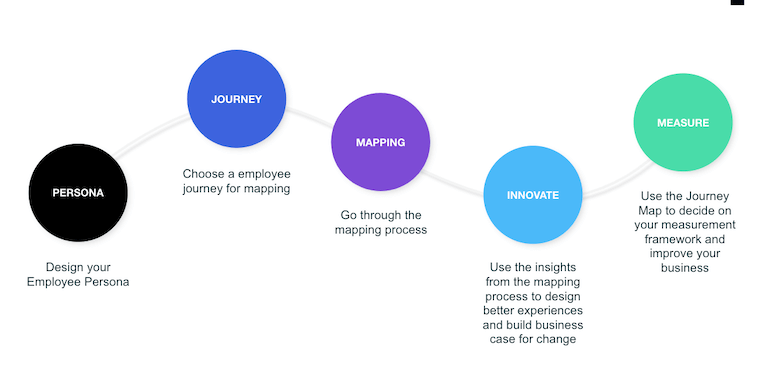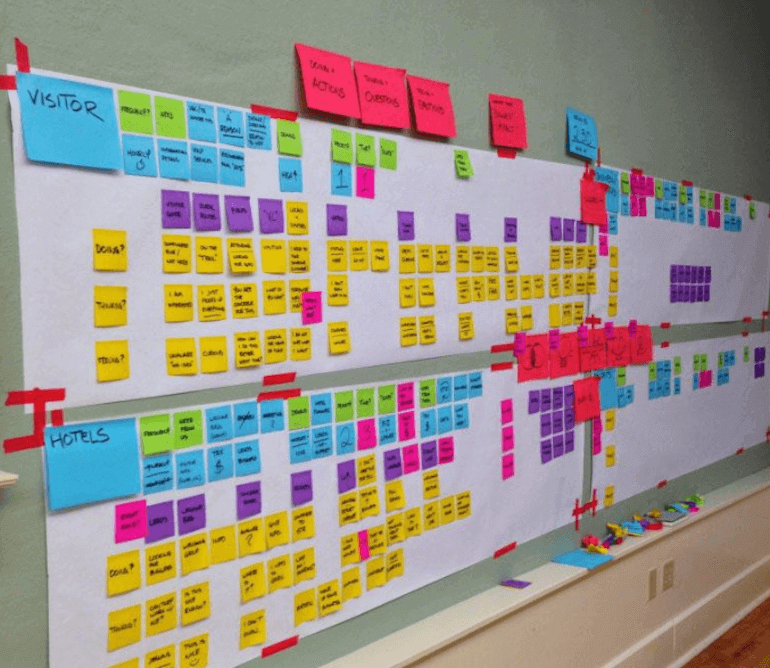
Employee Experience
6 steps to mapping the employee journey at your organization
Close employee experience gaps by mapping your people’s journey with your organization.
In order to master employee experience, you must listen to your people at each stage of their journey with your organization. To do so you first need to map that journey, an easy and impactful exercise that reveals opportunities for improvement and optimization. Here’s how to do it.
eBook: Use Employee Lifecycle Feedback to improve your EX
What is the employee journey?
From the moment someone looks at your careers page to the moment they leave your organization, everything an employee learns, does, sees, and feels is part of the employee journey. The employee journey is a framework used to understand the sum of all the employee's experiences during their time with an organization and it's used by HR to understand and enhance the employee experience.
These moments and milestones (big and small) contribute to their employee experience – and present opportunities to tune in to your employees’ needs, to be more equitable and inclusive, and to close the gaps that exist for employees.
If you want to improve employee experience you need to map the journey your employees go through while they’re employed by your organization.
What is employee journey mapping?
An employee journey map is a visual representation of each stage of an employee's time within an organization from recruitment, through onboarding, right up until the time they leave.
Employee journey mapping enables organizations to prioritize resources and funding, clarify roles, and identify critical moments that matter by visually mapping the various steps and emotional states which employees experience while interacting with the company.
Employee journey mapping allows you to:
- Align the organization on a common view of the actual employee experience.
- Focus the EX program on moments that matter most.
- Facilitate employee-centric thinking and actions.
- Prioritize resources and funding.
- Clarify critical roles within the organization and moments that matter most.
What are the benefits of employee journey mapping?
More and more organizations are looking to capture feedback and insights at every stage of the employee journey. Doing so allows you to understand the moments that matter most, how those moments impact employee experience, and what to do at each stage to have a positive impact on metrics like engagement, attrition, and productivity.
A key benefit of employee journey mapping is to use the insights from the mapping process to design and execute better experiences throughout. You do this by:
- Revealing and optimizing unseen experiences. Journey mapping helps you think about the more hidden aspects of the employee journey.
- Finding out where the employee journey runs smoothly and leveraging what’s working well in other moments of the journey so as to meet employees’ needs at various moments in time.
- Fixing bad experiences more effectively. Journey mapping helps reveal why you haven’t met employee expectations and what you need to do to make amends.
- Identifying opportunities to foster equity and inclusion. There is rarely a single critical point in the employee journey that creates inequity. It’s often the cumulative impact of bias and systemic inequity over many moments that create significant gaps in experience.
Collect and apply employee feedback with our 360-Feedback eBook: Download Now
What are the stages of the employee journey?
Every employee goes through a series of stages from the day they apply for a job right through to the day they leave. This journey can be summarized into five stages:
Stage #1: Recruitment. This includes all the steps that lead to hiring a new employee. Considerations are: how long it takes to hire, how much it costs to hire, the rate of offer acceptance, and the hire’s quality. Were your job postings attractive and clear enough to catch the attention and applications of the best candidates? Did your interview process engage and reassure great candidates so they quickly accepted your job offer?
Stage #2: Onboarding. Where a new hire gets up to speed with the systems, tools, and processes, as well as the role’s expectations. Most new employees need ‘ramp time’ to get up to speed and become productive in their job. An effective onboarding process translates someone’s initial enthusiasm for their new job into a more meaningful, long-term connection to the organization and a commitment to doing great things while they’re there.
Stage #3: Development. This is the ongoing stage in the employee journey, with individuals developing at different rates and across a variety of skills. As the employee develops within his or her role, you need to quantify their productivity, ability to be a team player, and promotion aspirations. You also want to offer them the chance to expand their skill sets, an increasingly important differentiator for many employees looking to have a ‘portfolio career’ consisting of many different experiences.
This stage often includes incremental steps or annual events, like:
- Role changes
- Promotions
- Performance evaluations (e.g., career conversations, training and development)
Stage #4: Retention. Employees are now fully ramped and integrated into the organization. Your challenge then is to keep them performing, developing, and contributing to the company’s success. Plus, to ensure they’re inspired by and connected to the company’s core vision.
While there are countless strategies organizations use to retain talent, programs that support EX can often look like:
- Inclusive parental leave
- Extended leave or sabbaticals
- Celebrating anniversaries and birthdays (or other personal milestones)
Stage #5: Exit. Employees can leave for a whole host of reasons: they may retire, move to another employer, or make a life change. Every employee will leave your company at some stage, and finding out why is an opportunity to improve and develop the employee experience for current and future employees. Those who leave may be more candid about why they’re going as they may feel they have nothing to lose by being brutally honest.
How to design an employee journey map
An employee journey map allows you to plot out every moment that matters and understand what you can do to improve the experience. Here’s how to start building your employee journey map.

Step #1: Segment your employees.
Start by identifying your employee segments, also known as employee personas. Ideally, segments should be based on role, not on demographics like age or gender – you can use the latter to parse out the data later. An engineer, for example, is likely to have a very different experience from someone in your marketing team. Segment employees in this way, rather than demographics like age and gender
Step #2: Establish the journey for each persona.
Now that you know your personas, you can start to map out the interactions they have with the organization from their first contact (usually before they’re hired) all the way through to them eventually leaving. You’ll need to bring in a cross-functional team for input on this, as different teams and departments will likely have different interactions along the way. You may even want to consider looking at the interactions post-exit as in some cases retirees or past employees may come back or have an interaction with the organization later on or act as advocates for the organization.
Step #3: Map feedback and insights to the employee journey.
To truly understand the impact of each interaction on the employee experience, you need to be able to map feedback to each stage in the lifecycle. So for each persona, make sure there is a feedback mechanism attached to each stage in the journey that meets them where they are and provides them with the opportunity to give feedback in the moment – this is much more useful than waiting up to 12 months to ask them about it, as you’ll get the most honest and useful feedback while the experience is still fresh in their mind.

Step #4: Align your measurements at different stages in the employee journey.
It’s likely that different stages in the journey will be managed by different teams, e.g. your recruiting, training, or onboarding teams. In order to link insights across the journey, you need to make sure that everyone agrees on a consistent approach to measurement, whether that’s using a simple metric like eNPS with open-text follow-up questions or a set of core 5-point Likert scale items (e.g., Engagement) that are consistent across each measurement. The key is to have a set of core metrics that are consistent across many of your measurements. Exit and onboarding surveys may still have custom questions unique to those processes, but having a consistent set of items in each measurement allows you to look at connections to see how the experience at one touchpoint impacts the other.
Step #5: Use automation to manage feedback at scale.
Manually sending out a survey every time someone takes a training course, goes for promotion, or interacts with any of the other moments that matter along the journey is a drain on resources. Instead, make sure you integrate your employee experience program with your HRIS and set up triggers to automatically send a request for feedback when an employee hits a certain milestone.
Step #6: Combine the employee journey with your engagement survey.
A lifecycle approach to employee experience doesn’t mean giving up on your employee engagement survey altogether. In fact, the engagement survey should be your cornerstone – but more in-depth view of the state of employee experience and the key drivers that are impacting it either positively or negatively. Many organizations choose to do shorter, more frequent surveys like bi-annual engagement surveys or monthly employee pulse surveys as an alternative to the annual survey. However you run it, it’s essential you connect it to your feedback mechanisms across the lifecycle.
As an example, employee onboarding feedback, on its own, will likely show you how your onboarding process is perceived and what can be improved, but it won’t necessarily show the impact on engagement, productivity, or attrition. When you combine it with your engagement survey (which does measure these things) you can then start to see connections – how did that improvement to onboarding affect engagement for employees in their first year? Did it reduce attrition? Did it promote cross-functional collaboration? Do those employees who went through the new program understand better how their work contributes to the organization’s success?
It’s only by connecting all these different feedback mechanisms that you’ll know the answer.
Learn how to create actionable insights with employee journey analytics
The dos and don'ts of employee journey mapping
Do: Look at each phase from multiple angles
Each stage in the employee journey is different, so it’s important to look at each individually while considering multiple components of the stage. For example, if you just look at a stage from the vantage point of an employee, you may miss important considerations related to current business challenges. In that example, you may have employee feedback on your onboarding process that tells you employees do not feel supported, but that insight becomes much more tangible when you pair that with the knowledge that the onboarding team is currently very short staffed.
Do: Know your end game
An effective employee journey mapping process should always start with clearly defined outcomes. Without them, it’s impossible to know when the journey if complete or how you’ll use it to drive improvements.
Here are a few questions to ask yourself up front:
- What does a best-case output of the journey mapping work look like?
- What will this work inform?
- How will it influence people, processes, and tools?
- How will you measure its success?
- What problem are you trying to solve?
- How are you aligning this process and conversation to the metrics that matter and the current business problems in the organization?
Do: Be intentional about who you involve
This can be a tricky balancing act. It’s important to avoid “decision by committee” by involving too many people in your journey mapping session, however it’s essential to ensure those familiar with various steps in the journey are involved as they’ll have the best knowledge of all the components you need to take into account.
Here are a few roles to consider including on your journey mapping exercise:
- Cross-functional HR
- HRIS owner
- Learning and development representative
- Cross-representation of key employee groups
- Corporate and internal communications
- Business leaders and frontline managers
Do: Focus on key groups within the organization
Within any organization there will be multiple employee journeys — after all one person’s pathway through the organization is likely to be very different from the next person’s. But here is where it’s important to keep the end-game in mind - don’t get lost in small differences, otherwise you risk overcomplicating the process with too many journeys with very minor differences between them.
Think about distinct and significant groups, such as remote versus corporate office workers, where clear differences in experience exist or are already apparent. Take a retail company for example, the experience of your frontline employees in your stores is likely to be very different from that of your marketing team in your corporate office. In contrast it’s unlikely there will be significant differences between different store departments, say menswear and children’s clothing.
Don't: Take a ‘one size fits all’ approach
Don’t feel like you have to use a specific template or format to create your journey map. What is most important is the framework behind what you create – from there, organizations often use whiteboards or large sticky paper to brainstorm their journey maps.
Don't: Allow your journey map to stagnate
As the organization changes — say for example a reorganization occurs or a new succession planning process is put in place — you’ll want to revisit and update your employee journey maps to reflect any significant changes.
Journey maps are a supporting tool for the organization, the frequency with which you update them should be based on how you are utilizing them internally and the extent to which the organization and the roles within it have changed.
Remember - it’s a tool, not a solution
Most importantly, remember that journey maps are just a starting point to help your organization identify the next steps necessary to improving your overall employee experience. Journey maps should be a part of forming a broader employee experience strategy, - the real value and impact will come from the actions the organization takes whether that’s gathering additional feedback or giving people in the organization the tools they need to make improvements at each moment that matters.
Break down silos by combining your listening programs with employee journey analytics